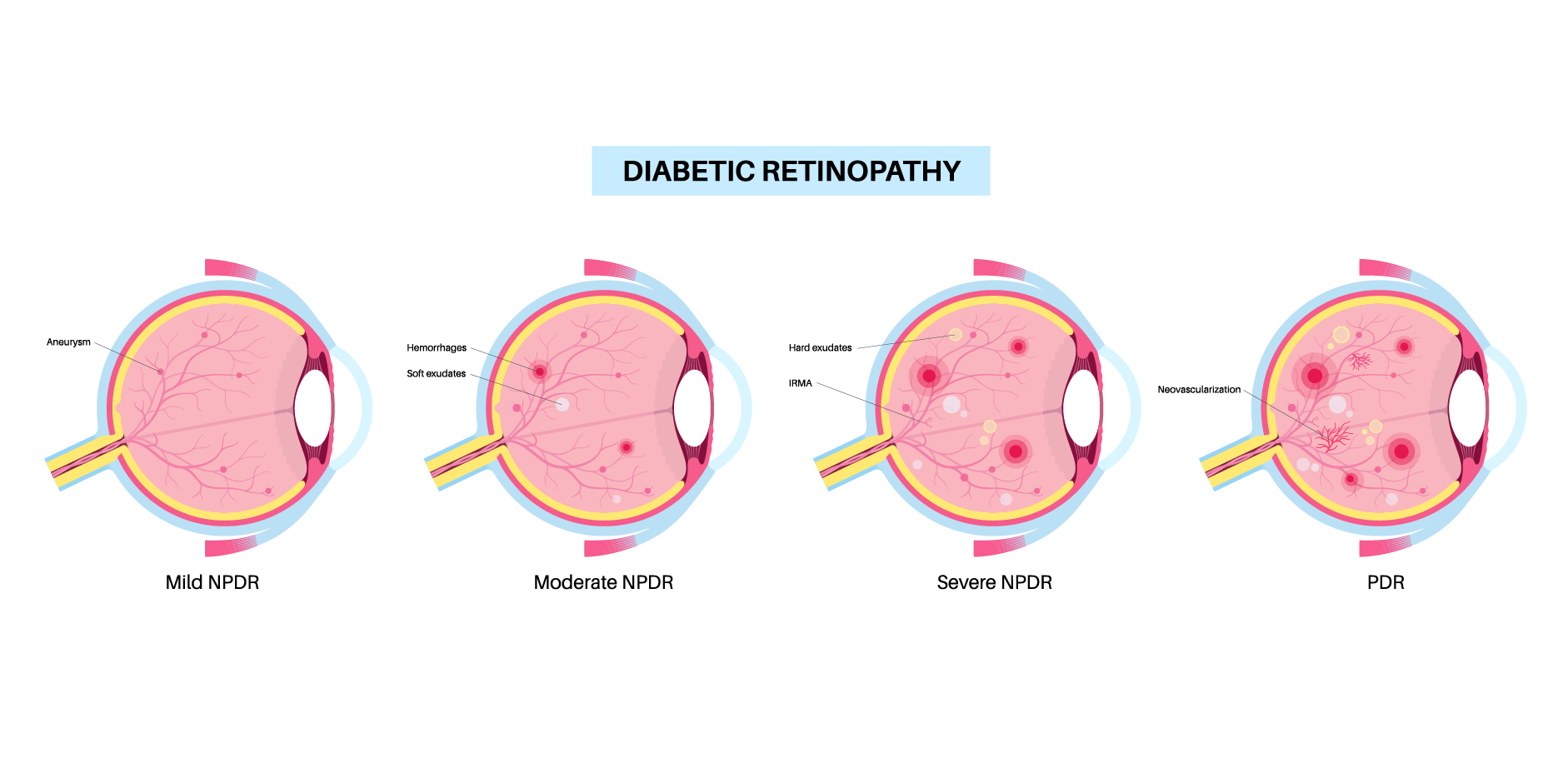Nội dung của trang này:
Nội dung của trang này:
Giới thiệu
Diabetic retinopathy is a progressive retinal disorder that occurs in
almost all patients with chronic diabetes mellitus (DM).
 Diabetic Retinopathy_Disease Background
Diabetic Retinopathy_Disease BackgroundDịch tễ học
Diabetic retinopathy is one of the leading causes of preventable vision
impairment and blindness worldwide. It is the principal cause of impaired
vision in patients aged 25-74 years. Diabetic retinopathy is also the leading
complication of DM. The estimated prevalence rate of diabetic retinopathy
worldwide is around 34.6% (93 million people). The prevalence of diabetic
retinopathy was noted to be highest in Africa (35.9%), North America and
Caribbean (33.3%), and the Middle East and North Africa (32.9%). While the
lowest was seen in South and Central America (13.4%). In the United States, the
noted prevalence of diabetic retinopathy in patients with DM 40 years old and
above is 28.5% (4.2 million people; those with vision-threatening diabetic
retinopathy is 4.4% (0.7 million people). Worldwide, the estimated prevalence
of vision-threatening diabetic retinopathy is around 10.2% (28 million people).
In Asia, the prevalence rates of diabetic retinopathy ranges from 10%
in India to as high as 43% in Indonesia. It is estimated that there are as much
as 30.6 million people in South-East Asia suffering from diabetic retinopathy,
with 9.6 million people with vision-threatening diabetic retinopathy.
Sinh lý bệnh
Diabetic retinopathy is believed to be the result of different
biochemical changes (eg aldose reductase, protein glycation, protein kinase C
activation, angiotensin enzyme expression, vascular endothelial growth factor
expression, etc) accompanied by blood retinal barrier increased permeability
and initially by increases in retinal blood flow. The resulting widened venular
caliber is a marker of the severity of diabetic retinopathy. Visual loss from diabetic
retinopathy is primarily caused by several complications, including macular
edema, vitreous hemorrhage, neovascular glaucoma, macular capillary
nonperfusion, and distortion or traction detachment of the retina.
The basic pathological changes in the retinal vessels involve abnormal
permeability and vascular occlusion with ischemia, leading to subsequent
neovascularization.
Yếu tố nguy cơ
The major risk factors in the development of diabetic retinopathy are the duration of diabetes and the severity of hyperglycemia. Other contributing risk factors are pregnancy, puberty, cataract surgery, and other medical conditions (eg hypertension and hyperlipidemia). Diabetic retinopathy is strongly associated with poor control of blood glucose, blood lipids, and blood pressure.
Phân loại
Types of Diabetic Retinopathy
Nonproliferative diabetic retinopathy
Nonproliferative diabetic retinopathy is the earliest clinically
apparent stage of diabetic retinopathy. It is characterized by abnormalities
primarily in the posterior retina and macula. These abnormalities include
microvascular abnormalities (eg microaneurysms, occluded vessels, and dilated
or tortuous vessels), intraretinal hemorrhages, nerve-fiber layer infarcts
(cotton-wool spots), and hard exudates. Visual loss in nonproliferative
diabetic retinopathy is primarily due to macular edema. As the diseases progress,
gradual closure of the retinal vessels occur that eventually results to impaired
perfusion and retinal ischemia. This is manifested by venous abnormalities (eg beading,
dilation, loops), increasing retinal hemorrhages, intraretinal microvascular
abnormalities (IRMA), and increasing exudation.
Proliferative diabetic retinopathy
Proliferative diabetic retinopathy is the most advanced stage of diabetic
retinopathy. It is marked by the onset of neovascularization of the inner
surface of the retina, that is induced by retinal ischemia. Neovascularization
(new vessels at the optic disc [NVD] or new vessels elsewhere in the retina
[NVE]) causes preretinal and vitreous hemorrhage, followed by fibrosis and
tractional retinal detachment. Proliferative diabetic retinopathy may develop
from existing severe nonproliferative diabetic retinopathy or without
substantial preceding nonproliferative diabetic retinopathy.
 Diabetic Retinopathy_Disease Background 2
Diabetic Retinopathy_Disease Background 2Diabetic Retinopathy Disease Severity Level Based on Findings upon Dilated Ophthalmoscopy1
No apparent retinopathy
- No abnormalities observed
Mild
Nonproliferative Diabetic Retinopathy
- Have microaneurysms only
Moderate
Nonproliferative Diabetic Retinopathy
- Presence of microaneurysms and other signs (eg hard exudates, cotton wool spots, dot and blot hemorrhages) but less than severe nonproliferative diabetic retinopathy
Severe
Nonproliferative Diabetic Retinopathy
- ≥20 intraretinal hemorrhages in each of the 4 quadrants
- Definite venous beading in ≥2 quadrants
- Prominent IRMA in ≥1 quadrant
Non-high-risk
Proliferative Diabetic Retinopathy
- Presents with neovascularization and/or vitreous or preretinal hemorrhage but does not meet the criteria for high risk proliferative diabetic retinopathy
High-risk
Proliferative Diabetic Retinopathy
- Have neovascularization within 1 disc diameter of the optic nerve head that are ≥1/4 to 1/3 disc area with or without vitreous or preretinal hemorrhage or
- Vitreous and/or preretinal hemorrhage associated with less extensive NVD or with NVE ≥1/2 disc area in size
1International Council of Ophthalmology. Updated 2017 ICO
guidelines for diabetic eye care. http://www.icoph.org/. Jan 2017.
Diabetic Macular Edema (DME)
Diabetic macular edema is characterized by thickening located within 2
disc diameters of the center of the macula. It can occur at any stage of diabetic
retinopathy and can run an independent course. It is recommended to be
evaluated through dilated examination using slit-lamp biomicroscopy, OCT and/or
stereoscopic fundus photography. DME is classified as either noncenter-involved
or center-involved. It must be noted that severity of DME can help determine the
appropriate treatment modality to give to the patient and follow-up
recommendations.
Diabetic Macular Edema Severity Scale Based on Observation Upon
Dilated Ophthalmoscopy1
No macular edema if there is no retinal thickening or hard exudates on
the posterior pole. DME is classified as mild if the retinal thickening or hard
exudates in the posterior pole is distant from the center of the macula. In
moderate or noncentral-involved DME, the retinal thickening or hard exudates
approaches the center of the macula but does not involve the center that is 1
mm in diameter. Lastly, in severe or central-involved DME, the retinal
thickening or hard exudates involves the center of the macula that is 1 mm in
diameter.
1Modified from: Wilkinson CP, Ferris FL III, Klen RE, et
al. Proposed international clinical diabetic retinopathy & diabetic macular
edema disease severity scales. Ophthalmology. 2003;110:1679-1680. International
Council of Ophthalmology. Updated 2017 ICO guidelines for diabetic eye care.
http://www.icoph.org/. Jan 2017.
Clinically Significant Macular Edema (CSME)
CSME may occur at any stage of diabetic retinopathy and defined to
include any 1 of the following features:
- Retinal thickening at or within 500 microns of the center of the macula (approximately ½ of the optic disc diameter)
- Hard exudates at or within 500 microns of the center of the macula, if associated with thickening of the adjacent retina
- Retinal thickening zone or zones of ≥1 disc area in size, any part of which is within 1 disc diameter of the center of the macula
CSME helps in differentiating the different types of diabetic retinopathy.
